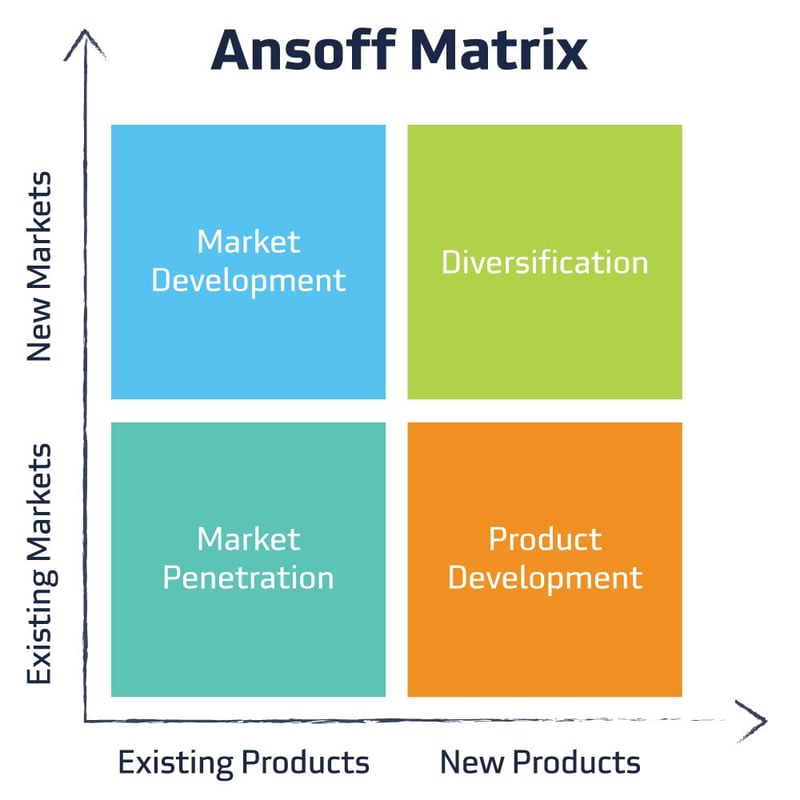10 B2B Marketing Strategies to Fuel Your Business Growth
 Krista
|
Krista
|

There comes a moment in every business venture when you know the time is right to grow your business. Whatever has driven your decision to pursue a growth strategy, success hinges on choosing the right strategy for your business.
You can use many B2B marketing strategies to drive sales and grow your business. One common starting point in developing a growth strategy is the Ansoff Matrix. The Ansoff Matrix, created by Igor Ansoff in 1957, helps you evaluate your risk within growth options and choose the right one.
The Ansoff Matrix and Business Growth
Building revenue and growing your business can break down into four buckets outlined in the Ansoff Matrix.

Market Penetration
The first bucket in the Ansoff Matrix involves getting more of your market. This strategy uses your existing products in your current market. It is the lowest-risk growth strategy in the Ansoff Matrix.
Market Development
This bucket requires getting into new markets with the same product. Examples of this strategy include selling your existing sports clothing line to non-athletes as athleisure wear or your office water coolers to homeowners concerned about water quality. While a higher risk than market penetration, market development is still considered a lower-risk strategy.
Product Development
Bringing new products to your existing market is the third growth strategy outlined in the Ansoff Matrix. Due to the loss of time and revenue that can result from a failed product launch, this is considered a high-risk strategy.
Diversification
Diversification is the riskiest strategy in the Ansoff Matrix and involves bringing new products to a new market. The most well-known and successful example of a diversification strategy is Apple's release of the iPod and other consumer-oriented products. They were the most known computers of choice for professional graphic and web designers.
Under each of these growth strategies, there are many marketing strategies to help you achieve the goal.
 How do You Increase Market Penetration?
How do You Increase Market Penetration?
The main idea behind market penetration is that there is more business in the market you are currently in than you have. You must attract and convert more people in your current market or audience. There are a few ways you can accomplish this.
1. Entice Current Market
The most obvious market penetration strategy is to get more customers from your existing market. However, that's easier said than done. A few B2B marketing strategies can help you find more customers in your market.
- Solve their problem and tell them about it: If members of your target audience need to be made aware of how your product or service can help them solve their problem, they aren't seeking out your business. Find ways to specifically communicate how you can solve their problem better than your competitors to draw them in and convert them.
- Ensure messaging is on target: Now is a great time to audit your marketing and messaging materials to ensure they are speaking to your target audience. Your word choice or tone may turn people off before they even make it to the decision-making stage.
- Can use sales or discounts to move the needle: Maybe some members of your target audience have been meaning to try you out but keep putting it off or think your product or service is too expensive. A sale or discounted prices can inspire new audience members to try you.
2. Consider an Upsell
Another market penetration strategy is to get your current customers to purchase more of your existing products. You can incorporate messaging into your marketing strategies that tell your customer base about a product that is related to the one they already have or are interested in. Let them know you're more than just one product or service, and get them back for more.
3. Acquire a Competitor
Buying one of your competitors is essentially buying more customer base because you will add their customer base to your existing customer base. There are a few things to consider before pursuing this strategy:
- Consider how you fold in the company to your mission, values, and processes.
- How will the branding of the new company look?
- How will you communicate the purchase?
 How Do You Build into New Markets?
How Do You Build into New Markets?
If you've determined that a market development has too small of an ROI or needs to be more aggressive for your goals, expanding into new markets is a great, more aggressive alternative. You can use a few different strategies to enter a new market.
4. Find and Enter New Territories
We're willing to bet that there are locations or territories that you have neglected to sell into as you were establishing your business. One way to build into new markets is to take your existing marketing, adapt it, and use it to break into untapped or unexplored territories. It's essential to complete some foundational activities before entering the new market:
- Review competition in the new market.
- Understand your value proposition.
- Know your audience and what problems you solve for them.
5. Enter New Distribution Channels
Are you currently selling directly? Could you utilize a distributor? Finding and using a distribution partner is a great way to access a new audience. Once you've chosen a distribution partner, you need to consider the following:
- How are the products presented, and will you use your current brand standards, or do they need to be adjusted for co-branding.
- How are the customers tracked and upsold?
6. Create New Segments
Are there new customer groups you could target outside of your current market? Now is a great time to review your current market and brainstorm opportunities for untapped segments ripe for your product or service.
 Product Development
Product Development
If you're ready for a more aggressive growth strategy, it's a great time to consider expanding your product offering. Let's review some ways to implement a product development strategy.
7. Developing Your Own New Product
Do you have an excellent idea for another product? Are your customers asking for something specific from you? These are great signs that it's time to develop a new product. Consider what else your current audience might need related to your existing product or service. If you are unsure, ask your customers what else they wish you offered, they often have great insight into other things they need or would be interested in buying from you.
8. Licensing Someone Else's Product
Maybe someone has produced and launched a product that would be a great companion to your product. An easy way to pursue a product development strategy is to investigate licensing a product that would enhance your catalog and provide something new to your customers.
9. New Product Updates
We're willing to bet you've gotten feedback from customers and users about features they would like or bugs they've experienced. This feedback would be great to incorporate into your product in the form of new product updates. Small or big changes to the product give you an opportunity to reconnect with customers and attract new ones.
 Diversification
Diversification
Finally, let's talk about diversification. The riskiest of all business growth strategies, diversification could have significant returns if successful. Diversification involves introducing a new product to a new market.
10. Expand What You Offer
There are two kinds of diversification you could pursue.
- Related diversification is pursuing a diversification strategy that is in some way related to your existing business.
- Unrelated diversification is seeking a product and market that are entirely new to your company.
When getting started with any of these strategies to try and meet your business goals, keep it simple so you don't get overwhelmed. Each has unique aspects that need to be executed, but here are three basic steps.
- Define your challenge and what you are trying to do, and create your goals
- Create a clear picture of your products, messaging, landscape, and create a plan
- Take action, and execute the plan using the messaging and frameworks you have created for your products to reach your goals
Where To Grow From Here
Success Hinges on Your Best-fit Business Growth Strategy
With so many options, it can be hard to determine the next best steps to keep your company growing. TANK's Growth Programs can help with this process. We help determine where there is a growth opportunity, walk you through all the steps to get the marketing up and running, and consistently deliver work and report on the results.
Subscribe to Our Blog
Stay up to date with the latest marketing, sales, and service tips.


